ENGLISH ACOUSTICS 21C POWER AMPLIFIER
Janine Elliot already listened and wrote about the pre-production model, and Stu and Lin bought a Pink Hifi Pig edition one on the back of that review. Here’s the review of the final production model by Janine with supplementary comments by Stuart.
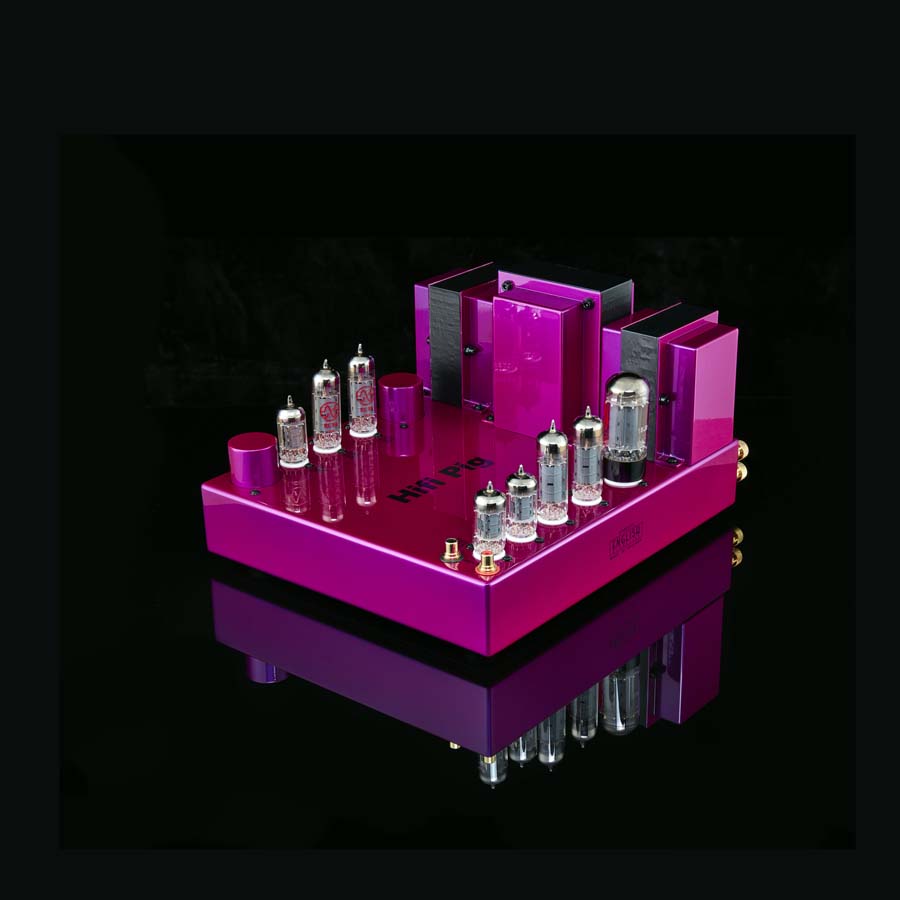
As Henry Ford didn’t say, the 21C is available in pretty much any colour you like.
I have already had the excitement of owning a Leak Stereo 20 and then I got to review English Acoustics uptake on the original, the pre-production Stereo 21c (“21st century”) at the start of 2021. That was an excellent amplifier, speeding up the original’s relaxed but very musical performance. So, would the new improved production version be any better? Stay tuned. The original Harold Leak Stereo 20 hit the world in 1957. Even he wouldn’t have guessed we’d be ogling the amp still 64 years later. The tube amp was called “20” as it had 10 watts per channel with an excellent and world beating 0.1% distortion. It’s industrial look and slow and treacle sound was, and still is, very popular to this day, with many originals appearing up for sale at over £1500. Harold’s Stereo 30 became his first transistor amp and it never quite received the same acclaim. IAG started up the name “Leak” again a few years back and brought out their incarnation of that relatively unsuccessful amplifier, the Stereo 130. They didn’t attempt to recreate the Stereo 20. That was left to Chief Technical Officer Peter Farrow, ex BBC engineer, and Chief Operations Officer Jordan Jackson, who established English Acoustics in Wiltshire officially in 2018.
ENGLISH ACOUSTICS 21C CONSTRUCTION
So, how different is the new Stereo 21c to the one I reviewed in January? Whilst they still look the same, there have been a number of changes under the skin. For a start, they have a new transformer manufacturer that is more local to them and who delivers improved performance. That means full power from 13Hz to 78KHz, instead of 20-20k as in the original. Output is now 6Ω as opposed to 8Ω in the pre-production model (the original Leak had a user-selectable choice of 4, 8 and 16Ω) Total harmonic distortion remains at 0.1% but power output has now risen to 14W/channel. The amplifier continues the same valve allocation of a pair of EL84 per channel in the output stages and using two ECC83’s in the driver stage of the design. The rectifier is the capable GZ34. With Tung-Sol valves the ECC83’s are gold plated for better contact. As in the original Leak there is point-to-point wiring internally. The Stereo 20 and pre-production Stereo 21c had a very high output (meaning my MFA preamplifier volume control had to be set extremely low), so the new Stereo 21c has a lower output meaning I have more steps on my transformer preamp to caress to the optimum level. Saves me adding attenuation pads on the gold-plated RCA sockets. Further improving on the original 21c the chassis is now made by another local company having a much tighter tolerance ensuring that the fit and finish is even better. This also allows the paint to have an even better finish than the original Stereo 21c, and is exemplary. This is an all British made product, just as the original Stereo 20, and English Acoustics are members of the Made in Britain partnership, the only valve amp manufacture to carry this title.
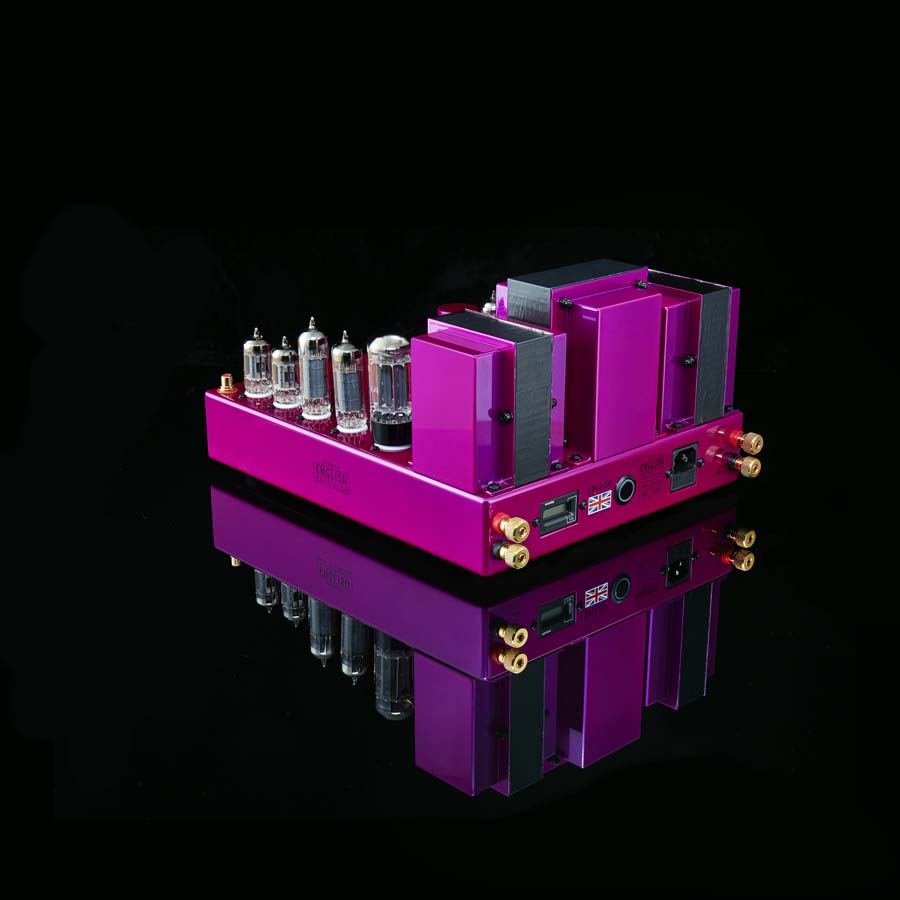
A soft push start button and a read out for hours in use around the back plus some pretty standard speaker binding posts.
Improved, too, are the safety features. Mr Leak’s original Stereo 20 had a100Ω/3W resistor soldered upside down at the side of the unit so that when the unit got too hot and putting in danger the transformers it would de-solder itself and drop off! Luckily things are a little more sophisticated in the 21st century, and the bomb-proof Stereo 21c comes with an advanced tilt sensor, over-current sensor, heat sensor and a vibration sensor – designed for Japan, who need it due to earthquakes. If any of these features trip, you will not be able to turn on the amplifier before first discharging the amplifier by unplugging it. There is also a digital clock to give you a reading of total hours you have used the valves.
Capacitors are their own design paper-in-oil. The original Stereo20 had capacitors inside the two “cylinders” on top of the unit. As they started to leak (sic) and needed replacing, many DIYers simply removed the cylinders completely and had bare replacement caps sticking through the holes. Not a very good-looking repair, nor safe. What English Acoustics have done is take a new capacitor, strip the outer metal and rubber then paint it the correct colour and place it in the hole. It looks perfect.
ENGLISH ACOUSTICS 21C COLOURS
The original 21c’s came in a large variety of colours, including “Lansdowne Gold”, “Tor Black” and “Stonehenge Silver” as does this full release version. To top it all off, even the power switch has the same colour LED. The result looks magnificent, unlike the original Stereo 20 which was usually destined to be hidden in a wooden cabinet. If none of the 12 colours will do, it can be built in any you like for a further £500, so you can match it with your favourite car or handbag, oh, and also come with a matching designer mains cable.
SOUND QUALITY OF THE ENGLISH ACOUSTICS 21C AMPLIFIER
Initially I wasn’t happy with the sound, but this was simply because I didn’t give it a chance to warm up. After just fifteen minutes I was in heaven. It does need time to sound at its best, just as in the original Leak. Initial findings were quite obvious; the music was even more controlled than the Mk1 version; bass was tighter and the top end carried on up, making trumpets and cymbals just sing. I felt it was also a quieter amplifier than I remember the former. This was pure class and certainly warranted the £5000 asking price. Listening was begun with my trusty Chasing the Dragon II taster disc. I know this CD so well (having been at the original recording of some of the tracks), and was mightily impressed with the prolific and extended bass, the speed and the dynamics. This was not the original Leak treacle sound, but rather razor-sharp, though still maintaining the musicality and warmth of the original that made it so famous. In this respect, this amp puts to shame others costing significantly more. Mr Leak was so clever, and English Acoustics have improved things even further.
Turning to Kitaro ‘Live in America’, this album has a great atmosphere, so you could be convinced this was recorded in an open field at night. Actually, it was recorded at the Fox Theatre in Atlanta, Georgia in 1990, as part of his world tour. The album is very ethereal with lots of space and a Vangelis and new-age style of composition. The EA accentuated the thunder in “Hajimari” that I didn’t realise my LS5/9s could get so deep. The amplifier kept all the detail well under control with each instrument placed perfectly in the large soundstage.
The trouble with the Kitaro is that it is just too laid back and even the original Leak would sound astounding, so time to quicken up the transients a tad…
Time for Derrin Nauendorf ‘Live at the Boardwalk’. This is quite minimalist having just acoustic guitar and solo vocals from Derrin and percussion from David Downing. Not only was this album equally atmospheric with a great feeling of transparency and clarity, but everything was tighter and energetic. “Leave Me Tonight” has some brilliant playing on the guitar with the lowest string tuned down a tone to a “D”. This was exciting and feisty playing that the EA pulled off with great enthusiasm plus equal sensitivity. Bass was full and both instruments’ decay of notes and rhythms were allowed to tail off in their own time.
London Grammar’s “Rooting for You” (from the album ‘Truth is a Beautiful Thing’) has a vibrant vocal, with tons of reverb on her voice which is allowed to tail off in its own time. The very ethereal accompaniment with violin, cello and guitar is highly evocative with the rumble from the percussion at the end pushing my LS5/9s to the end of their lives.
Testing the bass end further I put on “*” from Bowie’s epitaph ‘Blackstar’ album. That bass is much improved on the original 21c. Similarly, “Dollar Days” was very atmospheric with plenty of space for detail, the composer singing as if he knew he was soon to die. I love this track as it is so sad.
Haydn’s Symphony No 44 in E minor is also supposed to be sorrowful, known as the Trawer Symphonie; the mourning symphony. Marco Boni’s rendition of this isn’t as sad as the Bowie. This is a powerful performance from the Stereo 21c, with very decisive playing and opening up the music much further than I have heard before.
Turning to jazz I first tried a digital file of Django Reinhardt’s ‘Hotel Club de Paris’. This is a mono performance but that didn’t lessen my enjoyment of the music. It all sounded tight and controlled and still fun. On to Miles Davis Quartet’s ‘Freedom Jazz Dance’ rehearsing album, one I have used in many reviews, the atmosphere in the studio as they worked out the tunes was equally compelling, even if there was very little music per se. I also played several of the tracks I listened to in my original Stereo 21c review; music by Bach, Rutherford, Metheny and ELO. The original amplifier illustrated the excellent bass from organ and delightful droplets of sizzle from the ride cymbals in the Metheny. The new 21c simply carried this on further. That bass seemed more extended as did the top end theoretically all the way to 78kHz. But it just did it all with more heart, more emotion, and more musical energy. Listening was just that much more real.
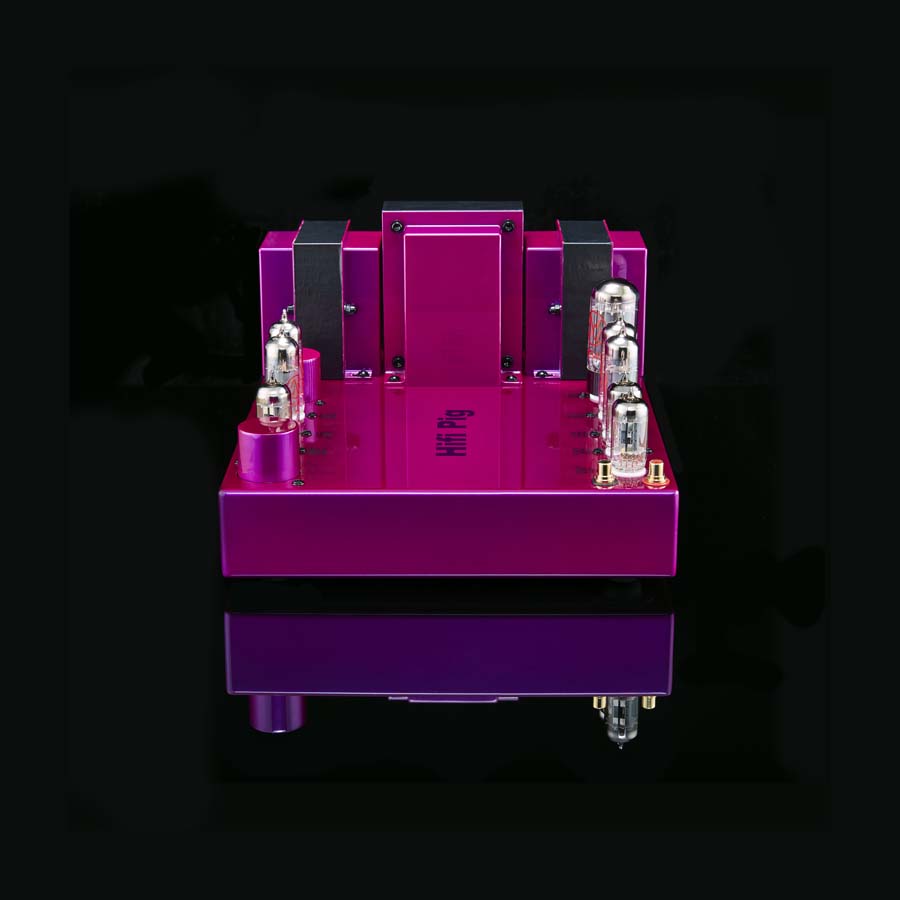
It’s certainly a looker. RCA inputs are on the top at the front.
CONCLUSION
So, was it worth doing a new review on a product that had already received a great review? Absolutely. This amplifier is even better than the one I originally listened to. It tackled classical and jazz with magic, and even heavy rock and punk didn’t phase it. The 21c pulled out every syllable of the music with much detail and passion. To think a new Stereo 41c is in the pipeline along with an 18 valve pre-amplifier. I think English Acoustics are a name you should start to take seriously.
AT A GLANCE
Build Quality:
Immaculate finish both internally and externally, with point-to-point wiring and lots of colours to choose from!
Sound Quality:
Detailed and passionate performance as a valve should be and with speed and power of a solid-state offering
Value for Money:
The new £5000 price tag is very good value for such a confident performer.
We Loved:
Sheer musical performance
Faster transients
Tight and well-defined bass end
Transparency and clarity
We Didn’t Love So Much:
Some may find it just a little too polite
I don’t particularly like the black strips on the transformers and chrome would look better!
Price: £5000
Elevator Pitch Review;
Getting a ECC83/EL84 amplifier any better than the 64-year-old Leak Stereo 20 or English Acoustics original Stereo21c was going to be a hard task, but boy have they somehow managed to pull it off. Bass is tighter and extended as is the top end and it sounds even more musical. With better articulation and finesse, could this be an amp we talk about in 64 years time.

Janine Elliot
Review Equipment:
Ferrograph Logic7 (reel to reel), Fiio/Sony/iFi (digital streaming), Pre-Audio/AT33sa/Manley Steelhead (phono), Krell KPS20i (CD), MFA Baby Reference (pre-amp) Graham Audio LS5/9 plus Townshend Supertweeter (speakers), Tellurium Q Ultra Black, Townshend Isolda and F1 (cables).
Janine sent in this review with a large and bold SIX HEARTS AWARD. We don’t do six hearts and so it’s over to Stu to see if the English Acoustics 21C is worthy of our top award.
I’m going to start this addition to Janine’s full review with a bit of an odd statement that sort of contradicts the final award I’m giving this amplifier. Now, this comment may well seem a bit at odds with what you’d expect given that I’m giving this amplifier from English Acoustics our highest award – (spoiler alert) the Editor’s Choice. What I’m going to say may also seem to fly in the face of what our highest award should represent, but I will go on to try and explain my thoughts around this and hopefully you can see my logic. There’s a famous quote along the lines of “The best amplifier is a straight wire with gain” and it’s variously attributed to Peter Walker of Quad or Stewart Hegeman of Harmon Kardon. Whoever originally said it, essentially the quote is saying that the perfect audio amplifier would be an amplifier that added zero of its own character to what we hear. This is not the Stereo 21C’s character, and if your main goal when choosing an amplifier is that “straight wire with gain”, then I suggest you look elsewhere. However, if you are looking for a relatively low output (14W per channel) amplifier that has character, sounds wonderful, and manages to connect you with the music you are listening to then this amplifier may well be right up your street. Yes, I’m aware that if we are talking in strictly “high-fidelity” terms then the 21C may well fall short of the strict definition, however, when I listen to music for pure enjoyment I’m not really looking for the nth degree of analytical resolving power, and I’m not wanting to sit and feel I need to over-think the process. I’m looking for something that connects me with the music on an emotional level, or I’m wanting something that makes me want to get down and boogie. The 21C scores magnificently on the former, and with the right speakers has a good crack at the latter.
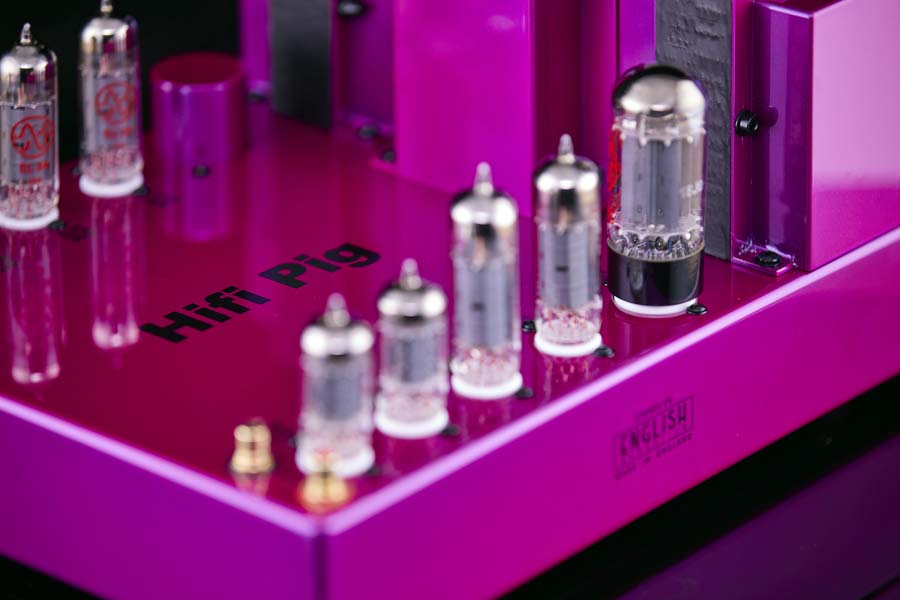
A classic brought bang up to date.
The amplifier is not perfect – it’s not as transparent an amplifier as, for example, our Merrill Thor amps, and it’s not going to rock the house in the same way our Krell amp can. No, these two amplifiers are very different to the English Acoustics amp, and when you start to think about buying one you need to be fully aware of this. I’ll give you another example of a well-respected HiFi legend that is far from perfect, and that is the BBC LS3/5A and you need to put the English Acoustics into that kind of context. Am I suggesting that the 21C belongs in the same kind of revered circles as, for example, the Falcon LS3/5A that we use, then yes I am, most definitely. Both products are imperfect, that’s for sure, but it is those imperfections and the ability to get some things absolutely right that sets them apart as modern classics. And yes, I am saying that the English Acoustics 21C is a modern classic in any way you care to define that statement.
I’m going to get asked how the 21C compares to the original Leak Stereo 20, but the truth is I have absolutely no idea. Of course, I’ve heard the S20 numerous times, but I’ve never owned one and I’ve never sat down to pore over the minutiae of its character and its delivery of music, and I’m certainly not one to pretend I can recall the character of a product I listened to months or even years ago – no, I’ll leave that to others. I’m not looking at the 21C in those terms, though I’m sure some reviewers down the line will obviously do this and directly compare the two amplifiers side by side and in a proper head to head, much as Janine has done for HiFi Pig.
Let me start with the fit and finish of the 21C. It’s stunning. Of course, we have specified a bit of an outrageous colour for ours – yes, I ordered one on the back of Janine’s original review of the preproduction model for HiFi Pig as I trust her judgement implicitly – but you can basically specify any colour you fancy and to suit your home décor, or just as a statement piece on your HiFi rack. Put it this way, once you receive your 21C you aren’t going to want to hide it away. On the fit and finish, I have only two negative comments, and they are that I’d like to see an old fashioned chrome toggle switch on the back instead of the soft push button, and I’d like the speaker binding posts to be better quality and further apart – I was unable to use the large spades at the end of a couple of or lengths of speaker cables for fear of the spades touching and had to use cables with banana connectors. Not biggies, but worth mentioning. I spoke to English Acoustics about the possibility of a toggle switch but this is apparently not possible given the requirement to turn the amp off when disconnected from the mains, though you can request a bypass on this at the time of order to allow the use of smart switches and voice control doodads. That’s it on my comments on this amplifier’s build and everything else is as near perfect as damn it. On the top of our rack upstairs, it looks absolutely fantastic and I know that anyone who gets to listen in this room (not many people at all) will certainly want to know more about the amp. It’s one of those kinds of products – it has a personality, something often lacking in modern components, and not just in the HiFi world. If you are a car fan you will be aware of several homage motors that are based on classics – think the Eagle remakes of the Jaguar E Types. These modern remakes take the classic cars and bring them up to date with modern components and modern construction techniques, and I think this is pretty much the essence of the 21C – a modern take on a stone-cold classic.
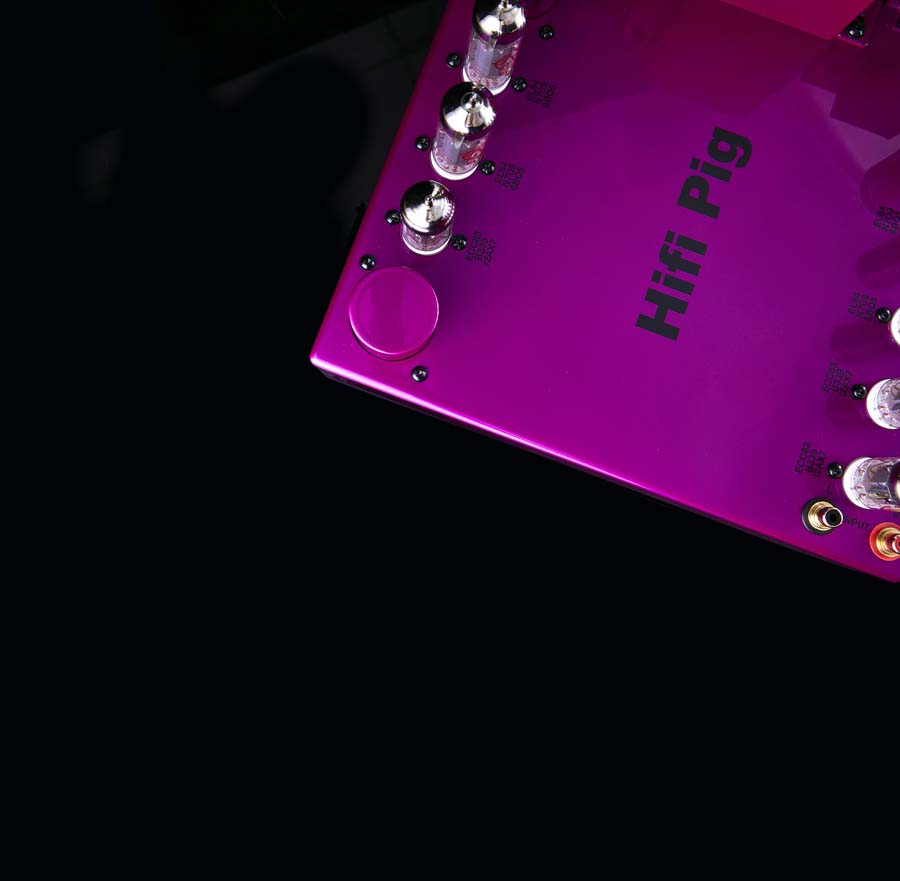
The 21C will take pride of place on any rack. Certainly not a product designed to be hidden away like the original S20.
The first afternoon I spent with the English Acoustics amp was meant to be no more than a plug it in and see if it works exercise, but it turned into a full afternoon and early evening exploration of music and matching it with speakers. First, it went on the Xavian Perlas and it sounded fab, a great start but hiding in the corner were the Falcon LS3/5A speakers that I knew would end up on the end of the amp sooner or later. Hours into this extended listening session Linette came into the room and said “I just knew that’s the speakers that you’d end up using!”. It was a no-brainer to be honest – two modern-day takes on two classics of yesteryear, though the S20 was introduced in 1958 (read all about it here) and the LS3/5A in the mid-seventies. Once the Falcons were in place everything just seemed to fit into place for me, though I am under absolutely no illusions that there was a certain degree of nostalgia/pride/they-ought-to-work-together clouding my judgement. I don’t care about this less than analytical approach to this “review” that’s not what it’s about and, let’s face it, there are going to be better sounding speakers and amps out there at similar prices. Don’t let this put you off either! I’m not a machine and I’m not some kind of measurement tool, I am a human being and in this case, I fully allowed myself the indulgence of dropping my analytical guard and just allowing myself to fully enjoy the experience…and what an experience. I’ll go into more detail shortly but I ended up just losing myself for hours in the music, not listening to the amp and speakers but just appreciating the music I was listening to and taking zero notice of the part the kit was taking. Truly, one of the best audio moments I’ve had at home.
I left it a few days with only sporadic listening before I sat back down and listened properly to the 21C again. I wanted the initial giddiness and (perhaps) over-exuberance to be allowed to subside a little and for me to be able to approach this follow up review of Janine’s as I would any other. However, not a lot has changed and I still got a buzz from turning the amp on as I passed in the morning to allow it to warm up for an hour or so before I gave it a proper listen.
The Hi-res versions of the Pink Floyd records are now out on Qobuz and whilst I’m well aware it’s an audiophile cliché I stuck on The Dark Side of the Moon. There’s lucidity and a feeling of rightness to the sound here that just drew me into the record. The individual elements of the recording are presented both separately and as a whole making for a joyous listening experience. The synth line on On The Run had great texture and you can hear as the sound modulated very easily. However, it’s warm and has a depth to it that is just so satisfying to sit and listen to on this amp. This is a great listen on the other amps I’ve mentioned too with the Merrills being brighter and more analytical and the Krell being more upfront. This amp feels like it is playing music rather than a series of zeroes and ones. Time really does sound magnificent here and I’m almost enveloped in the textural bass note, whilst the toms fly around the soundstage in front of me. It’s more of an experience than just listening to the track and I’m drawn into to just listening/enjoying again. Is this perfect fidelity….nope, and I don’t give a monkey’s about that, it’s a feeling of being part of the event and, without wanting to sound all hippy-dippy, at one with the music. Yes, there’s colouration and, whilst fast, this isn’t as speedy as, for example, the Krell. The room is simply filled with music. Glorious music.
And I suppose this is the essence of this amplifier – it is, in my opinion, an amp that allows you to really get into the vibe of the music.
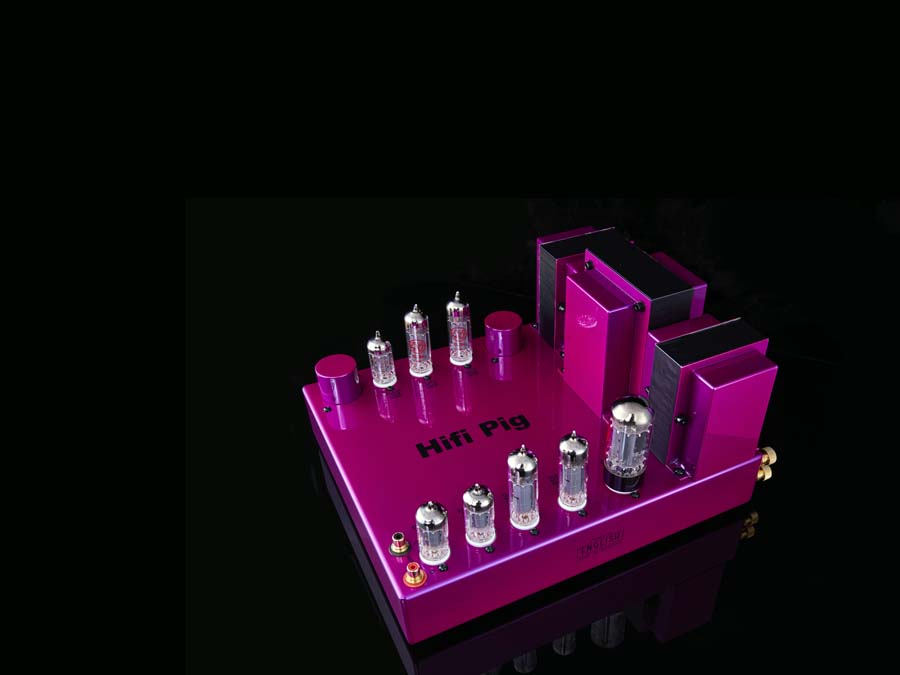
A rare musicality of sound that just draws you in.
HiFi Show cliché alert…again!!! Nils Lofgren is up next with Keith Don’t Go, and whilst I moan about hearing this song all the time at shows, there is no denying it’s a classic recording. There’s power and detail to the guitar and it sounds as natural as I’ve ever heard it – and I’ve heard it a lot. There’s a real openness to the sound of the guitar throughout the recording and it is allowed to resonate in the room, hanging there and showing Lofgren’s deftness of touch. His vocal is out front and clear as a bell, though I don’t actually think he’s got such a great voice. Did I mention this is about as good as I’ve heard this? Again, I end up listening to more of the record than I would during a review session. This is what this amp does, in my opinion. At the risk of repeating myself, it is an amp for music and not analysis.
So far so splendid, but what about whacking some proper techno through this amp? Up comes Surgeon’s remix of Hardfloor’s Strike Out. It’s a complex tune and has a lot going on…and the LS3/5A aren’t the greatest speakers for this kind of tune, but it’s clear the amp is speedy enough to keep up and digs deep enough to get the tune across properly in this room. The 303 on Into The Nature sounds like a 303 should and that hollow kick is wonderfully produced – the overdone reverb is clear to hear in the right-hand speaker too. I’d fully expected this amp to be absolute pants on this kind of program but it most certainly is not – it’s pretty incredible really. If I was to sit and take this recording apart then I’d no doubt hear stuff I could whine about but the truth is I just sat and enjoyed the music and when Plastikman’s Krakpot comes on I sit up and take notice.
CONCLUSION
It looks great and it sounds fabulous. Technically it’s not the most perfect amplifier in the world but then it’s often the imperfections in things that make them almost perfect and so endearing. I love it and can see this sat on the top of the rack in the smaller listening space full time. I have absolutely no hesitation in awarding it our top award, but you knew that already. On acoustic and classic rock it is wonderful and natural sounding. I’d assumed it would be crap with hard electronic music but it’s just not.
Make no mistake, this amplifier is not going to satisfy you if you are searching for the last word in absolute fidelity and it’s not an amplifier I will refer to much with regards to reviews as it’s not really a reference/review style of amp. However, it is an amp that draws you into the music playing and in that sense, it’s a fabulously good product that I can’t help but love.
The only negative is I still want better (and better spaced) speaker posts on a £5000 amp!
The long and short of it is that this amplifier is fab and I can’t do anything but give it our top award! 

Stuart Smith
Review Equipment: Falcon LS3/5A and Xanvian Perla speakers. Raspberry Pi running Riopeee with linear PSU. Lab 12 DAC, LAB 12 Pre, and LAB 12 power control. Cables by Atlas, Chord and Tellurium Q.

















































































































































































































